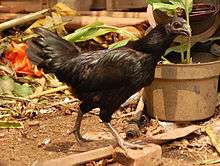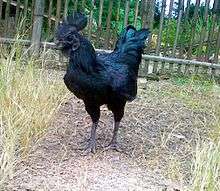Ayam Cemani
 Cemani hen | |
| Country of origin | Indonesia |
|---|---|
| Traits | |
| Weight |
|
| Skin color | Black |
| Egg color | Tinted / light brown |
| Comb type | Single |
| Classification | |
| |

Ayam Cemani is an uncommon and relatively modern breed of chicken from Indonesia. They have a dominant gene that causes hyperpigmentation (fibromelanosis), making the chicken entirely black, including feathers, beak, and internal organs.
Etymology
Ayam means "chicken" in Bahasa Indonesia. Cemani refers to the village on the island of Java where this breed of chicken originated.
Origin
The breed originated from the island of Java, Indonesia, and have probably been used for centuries for religious and mystical purposes. The breed was first described by Dutch colonial settlers[1] and first imported to Europe in 1998 by Dutch breeder Jan Steverink. Currently, this breed of chickens is kept in the Netherlands, Germany, Slovakia, and the Czech Republic. Ayam Cemani may have also been brought to Europe by Dutch seamen.[2]
Description
Their beaks and tongues, black combs and wattles, and even their meat, bones, and organs appear black. The blood of the Ayam Cemani is normally colored.[3] The birds' black color occurs as a result of excess pigmentation of the tissues, caused by a genetic condition known as fibromelanosis.[4] This gene is also found in some other black fowl breeds.[5][6] The roosters weigh 2.0–2.5 kg and the hens 1.5–2.0 kg. The hens lay cream-colored eggs, although they are poor setters and rarely hatch their own brood. Eggs weigh an average of 45 g.[7]
In the past, individual birds in the United States of America have been priced at $2500.[8]
See also
References
- ↑ Lukanov, H. A. Genchev (2013). "Fibromelanosis in domestic chickens" (PDF). Agricultural Sciences and Technology. 5 (3): 239–246.
- ↑ .It is also known as karaknath in India and is found in parts of Madhya Pradesh and Rajasthan.The word karaknath means god of vigour or shiva.European Poultry Society
- ↑ "'Public Radio International's 'The World'". October 14, 2016.
- ↑ Ai Shinomiya; Yasunari Kayashima; Keiji Kinoshita; Makoto Mizutani; Takao Namikawa; Yoichi Matsuda & Toyoko Akiyama (2012). "Gene Duplication of endothelin 3 Is Closely Correlated with the Hyperpigmentation of the Internal Organs (Fibromelanosis) in Silky Chickens". Genetics. 190 (2): 627–638. doi:10.1534/genetics.111.136705. PMC 3276631. PMID 22135351.
- ↑ Dorshorst B, Molin AM, Rubin CJ, Johansson AM, Strömstedt L, et al. (2011). "A Complex Genomic Rearrangement Involving the Endothelin 3 Locus Causes Dermal Hyperpigmentation in the Chicken". PLoS Genetics. 7 (12): e1002412. doi:10.1371/journal.pgen.1002412. PMC 3245302. PMID 22216010.
- ↑ Arora G, Mishra SK, Nautiyal B, Pratap SO, Gupta A, Beura CK, Singh DP (2011). "Genetics of hyperpigmentation associated with the Fibromelanosis gene (Fm) and analysis of growth and meat quality traits in crosses of native Indian Kadaknath chickens and non-indigenous breeds". Br. Poult. Sci. 52 (6): 675–85. doi:10.1080/00071668.2011.635637.
- ↑ Ayam Cemani
- ↑ Yahoo News